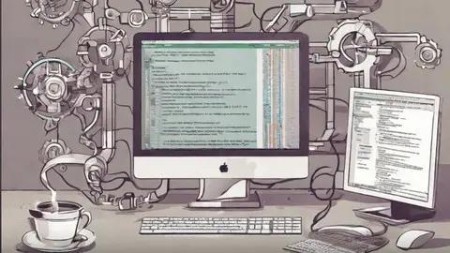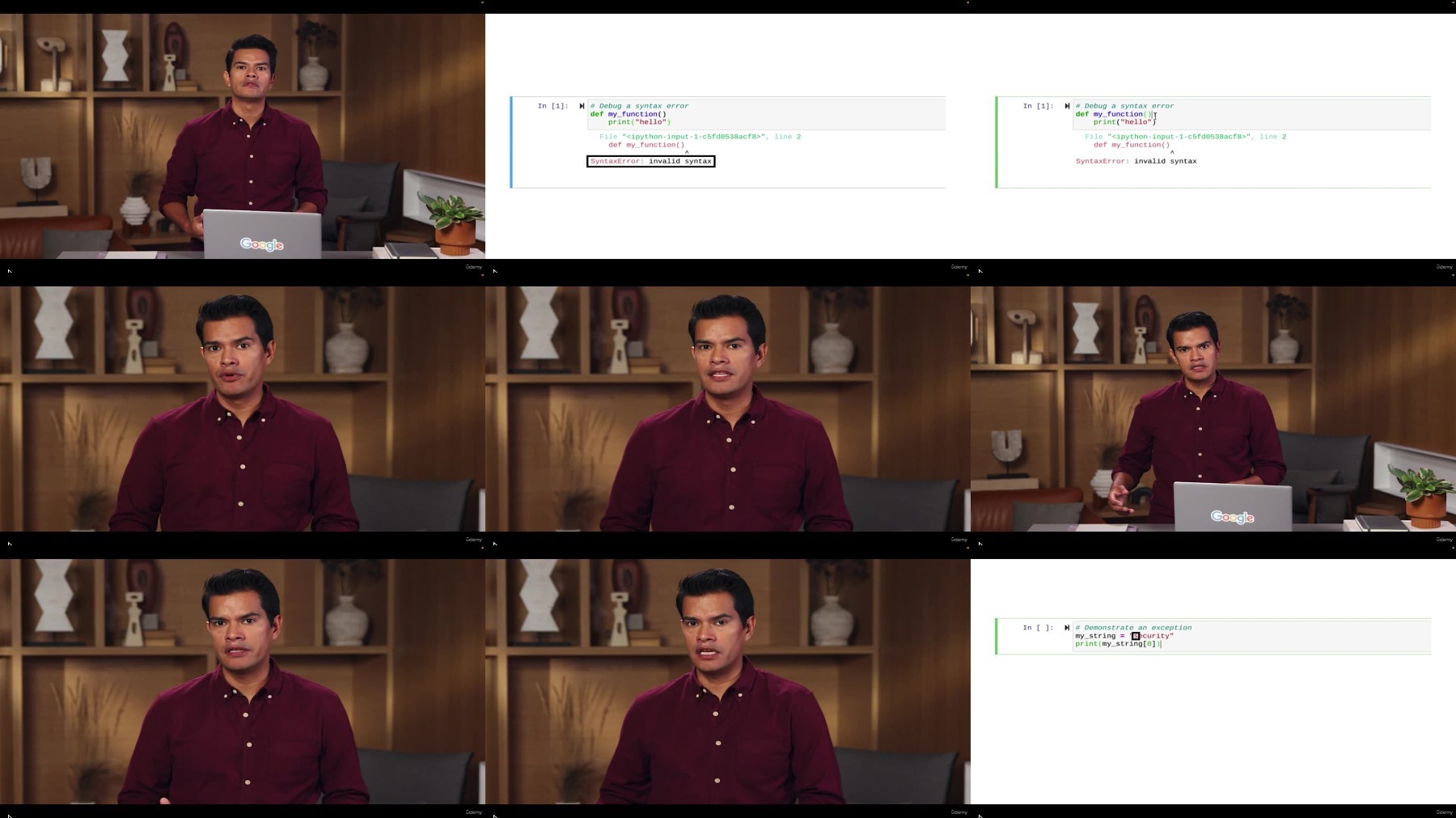Python Automation Hot Selling Course!

Python Automation Hot Selling Course!
Published 3/2024
MP4 | Video: h264, 1920x1080 | Audio: AAC, 44.1 KHz
Language: English | Size: 896.26 MB | Duration: 3h 58m
Automate Tasks with Python
What you'll learn
Introduction to Python
Write effective Python code
Work with strings and lists
Python in practice
Requirements
some computer knowledge
Description
Automating tasks with Python has revolutionized the way individuals and organizations streamline their workflows. Python's simplicity and versatility make it an ideal choice for automating a wide range of repetitive tasks across various domains. From file management to data processing and web scraping, Python offers an extensive ecosystem of libraries and tools that empower users to automate virtually any task imaginable. With libraries like os and shutil, Python simplifies file manipulation and system-level operations, allowing users to automate tasks such as file renaming, copying, and deletion with just a few lines of code. Furthermore, Python's subprocess module enables seamless integration with external applications, facilitating the automation of complex processes and workflows. For tasks involving web scraping and data extraction, Python's Selenium and Beautiful Soup libraries provide robust solutions, allowing users to automate interactions with web pages and extract data from HTML documents effortlessly. Moreover, Python's PyAutoGUI library enables GUI automation for desktop applications, making it possible to automate mouse and keyboard interactions with graphical interfaces. By leveraging Python's automation capabilities, individuals and organizations can significantly increase productivity, reduce manual errors, and focus on more strategic and creative tasks, ultimately driving efficiency and innovation in their operations. this will help you on your journey
Overview
Section 1: Introduction to Python
Lecture 1 Introduction to Python
Lecture 2 Python Overview
Lecture 3 Healthy habits for course completion
Lecture 4 Introduction to Python Programming
Lecture 5 more on python
Lecture 6 Get to know python
Lecture 7 create basic python script
Lecture 8 Python environments
Section 2: Core Python Components
Lecture 9 Data types in Python
Lecture 10 More about data types
Lecture 11 work with variables
Lecture 12 assign and reassign variables in python
Section 3: conditional and iterative statements
Lecture 13 Conditional statements in Python
Lecture 14 More on conditionals in Python
Lecture 15 For loops
Lecture 16 While loops
Lecture 17 more on loops
Lecture 18 wrap up
Lecture 19 Reference guide: Python concepts from module 1
Lecture 20 Glossary terms from module 1
Section 4: Welcome to module 2
Lecture 21 Introduction to Function
Lecture 22 Create a basic function
Lecture 23 Python functions in cybersecurity
Section 5: work with functions
Lecture 24 Use parameters in functions
Lecture 25 Return statements
Lecture 26 Functions and variables
Lecture 27 Explore built-in functions
Lecture 28 Work with built-in functions
Section 6: Learn from the python community
Lecture 29 Modules and libraries
Lecture 30 Import modules and libraries in Python
Lecture 31 Code readability
Lecture 32 Ensure proper syntax and readability in Python
Lecture 33 Reference guide: Python concepts from module 2
Lecture 34 Glossary terms from module 2
Lecture 35 Wrap-up
Section 7: working with strings
Lecture 36 Welcome to module 3
Lecture 37 String operations
Lecture 38 String indices and slices
Lecture 39 Strings and the security analyst
Section 8: Work with lists and develop algorithms
Lecture 40 List operations in Python
Lecture 41 Write a simple algorithm
Lecture 42 Lists and the security analyst
Lecture 43 Regular expressions in Python
Lecture 44 wrap up
Section 9: Review
Lecture 45 More about regular expressions
Lecture 46 Reference guide: Python concepts from module 3
Section 10: Python for automation
Lecture 47 Welcome to module 4
Lecture 48 Automate tasks with Python
Lecture 49 Glossary terms from module 3
Lecture 50 Essential Python components for automation
Section 11: work with python
Lecture 51 Access a text file in Python
Lecture 52 Import files into Python
Lecture 53 Parse a text file in Python
Lecture 54 Work with files in Python
Lecture 55 Develop a parsing algorithm in Python
Section 12: Debug Python code
Lecture 56 Debugging strategies
Lecture 57 Apply debugging strategies
Lecture 58 Explore debugging techniques
Lecture 59 Wrap-up
Lecture 60 course Wrap-up
Lecture 61 Reference guide: Python concepts from week 4
Lecture 62 Glossary terms from module 4
Lecture 63 Reference guide: Python concepts
Beginner Python Developers curious about data science,security analysts

https://fikper.com/RBCaTUIXRm/Udemy_Python_automation_hot_selling_course_2024-2.part1.rar.html
https://fikper.com/aVVXKfRaBW/Udemy_Python_automation_hot_selling_course_2024-2.part2.rar.html
https://rapidgator.net/file/f00aa3f337d43a5d6e7ceb2a8e7cf8ee/Udemy_Python_automation_hot_selling_course_2024-2.part1.rar
https://rapidgator.net/file/697f82da89eabd0a652d61dae5608a1c/Udemy_Python_automation_hot_selling_course_2024-2.part2.rar
https://filestore.me/4a00sbakwjgm/Udemy_Python_automation_hot_selling_course_2024-2.part1.rar
https://filestore.me/84mnscnggkw5/Udemy_Python_automation_hot_selling_course_2024-2.part2.rar
What you'll learn
Introduction to Python
Write effective Python code
Work with strings and lists
Python in practice
Requirements
some computer knowledge
Description
Automating tasks with Python has revolutionized the way individuals and organizations streamline their workflows. Python's simplicity and versatility make it an ideal choice for automating a wide range of repetitive tasks across various domains. From file management to data processing and web scraping, Python offers an extensive ecosystem of libraries and tools that empower users to automate virtually any task imaginable. With libraries like os and shutil, Python simplifies file manipulation and system-level operations, allowing users to automate tasks such as file renaming, copying, and deletion with just a few lines of code. Furthermore, Python's subprocess module enables seamless integration with external applications, facilitating the automation of complex processes and workflows. For tasks involving web scraping and data extraction, Python's Selenium and Beautiful Soup libraries provide robust solutions, allowing users to automate interactions with web pages and extract data from HTML documents effortlessly. Moreover, Python's PyAutoGUI library enables GUI automation for desktop applications, making it possible to automate mouse and keyboard interactions with graphical interfaces. By leveraging Python's automation capabilities, individuals and organizations can significantly increase productivity, reduce manual errors, and focus on more strategic and creative tasks, ultimately driving efficiency and innovation in their operations. this will help you on your journey
Overview
Section 1: Introduction to Python
Lecture 1 Introduction to Python
Lecture 2 Python Overview
Lecture 3 Healthy habits for course completion
Lecture 4 Introduction to Python Programming
Lecture 5 more on python
Lecture 6 Get to know python
Lecture 7 create basic python script
Lecture 8 Python environments
Section 2: Core Python Components
Lecture 9 Data types in Python
Lecture 10 More about data types
Lecture 11 work with variables
Lecture 12 assign and reassign variables in python
Section 3: conditional and iterative statements
Lecture 13 Conditional statements in Python
Lecture 14 More on conditionals in Python
Lecture 15 For loops
Lecture 16 While loops
Lecture 17 more on loops
Lecture 18 wrap up
Lecture 19 Reference guide: Python concepts from module 1
Lecture 20 Glossary terms from module 1
Section 4: Welcome to module 2
Lecture 21 Introduction to Function
Lecture 22 Create a basic function
Lecture 23 Python functions in cybersecurity
Section 5: work with functions
Lecture 24 Use parameters in functions
Lecture 25 Return statements
Lecture 26 Functions and variables
Lecture 27 Explore built-in functions
Lecture 28 Work with built-in functions
Section 6: Learn from the python community
Lecture 29 Modules and libraries
Lecture 30 Import modules and libraries in Python
Lecture 31 Code readability
Lecture 32 Ensure proper syntax and readability in Python
Lecture 33 Reference guide: Python concepts from module 2
Lecture 34 Glossary terms from module 2
Lecture 35 Wrap-up
Section 7: working with strings
Lecture 36 Welcome to module 3
Lecture 37 String operations
Lecture 38 String indices and slices
Lecture 39 Strings and the security analyst
Section 8: Work with lists and develop algorithms
Lecture 40 List operations in Python
Lecture 41 Write a simple algorithm
Lecture 42 Lists and the security analyst
Lecture 43 Regular expressions in Python
Lecture 44 wrap up
Section 9: Review
Lecture 45 More about regular expressions
Lecture 46 Reference guide: Python concepts from module 3
Section 10: Python for automation
Lecture 47 Welcome to module 4
Lecture 48 Automate tasks with Python
Lecture 49 Glossary terms from module 3
Lecture 50 Essential Python components for automation
Section 11: work with python
Lecture 51 Access a text file in Python
Lecture 52 Import files into Python
Lecture 53 Parse a text file in Python
Lecture 54 Work with files in Python
Lecture 55 Develop a parsing algorithm in Python
Section 12: Debug Python code
Lecture 56 Debugging strategies
Lecture 57 Apply debugging strategies
Lecture 58 Explore debugging techniques
Lecture 59 Wrap-up
Lecture 60 course Wrap-up
Lecture 61 Reference guide: Python concepts from week 4
Lecture 62 Glossary terms from module 4
Lecture 63 Reference guide: Python concepts
Beginner Python Developers curious about data science,security analysts

https://fikper.com/RBCaTUIXRm/Udemy_Python_automation_hot_selling_course_2024-2.part1.rar.html
https://fikper.com/aVVXKfRaBW/Udemy_Python_automation_hot_selling_course_2024-2.part2.rar.html
https://rapidgator.net/file/f00aa3f337d43a5d6e7ceb2a8e7cf8ee/Udemy_Python_automation_hot_selling_course_2024-2.part1.rar
https://rapidgator.net/file/697f82da89eabd0a652d61dae5608a1c/Udemy_Python_automation_hot_selling_course_2024-2.part2.rar
https://filestore.me/4a00sbakwjgm/Udemy_Python_automation_hot_selling_course_2024-2.part1.rar
https://filestore.me/84mnscnggkw5/Udemy_Python_automation_hot_selling_course_2024-2.part2.rar
